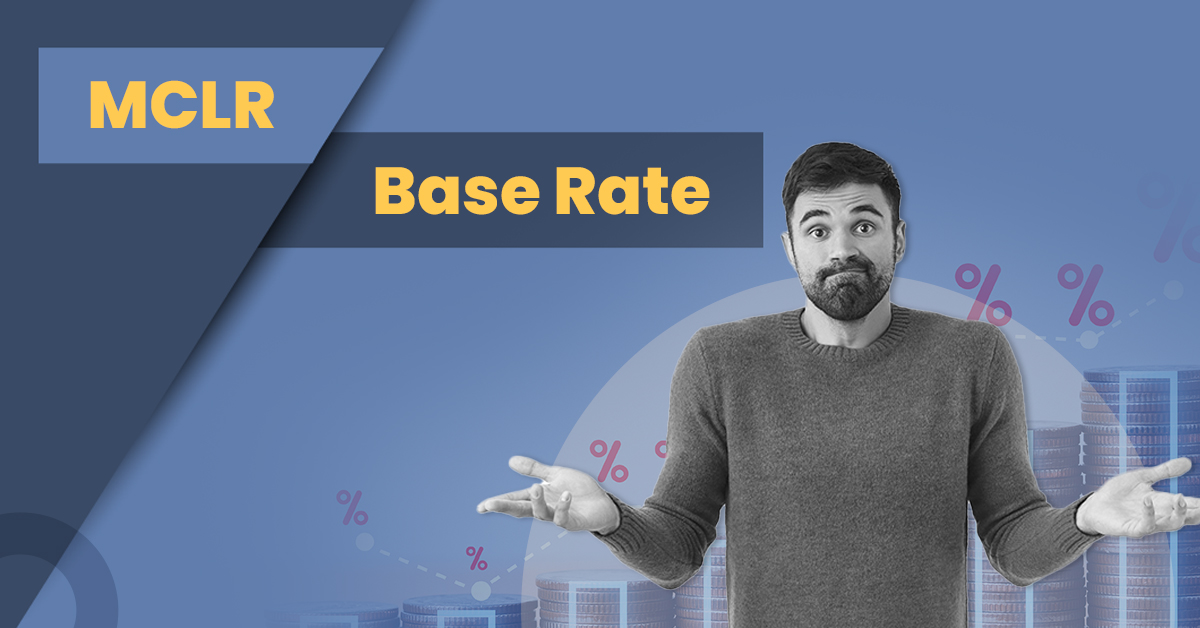MCLR vs Base Rate: Key Differences You Need To Know


Suppose you go to a bank to procure a home loan. Can they charge interest as they like? The short answer is no, as this depends on the marginal cost-of-fund-based lending rate (MCLR).
But what exactly is MCLR, and how is it different from the repo rate?
What Are Repo Rates? Why Are They Important?
To better understand how banks’ interest rates work, we must first understand the meaning of repo rate. In this case, repo means a repurchase agreement. This agreement is a short-term instrument that extends collateral-based borrowing. Accordingly, commercial banks sell their securities like bonds to the RBI for loans.
The repo rate is the interest rate at which the Reserve Bank of India (RBI) lends money to commercial banks in the country. This is done when there is a shortage of funds with commercial banks. This helps commercial banks maintain liquidity. When they repay the loan by buying back collateral, they have to pay an interest rate, i.e., the repo rate. RBI uses the repo rate to keep a check on the money flow in the economy.
Repo rates benefit both the commercial banks and the Central Bank. A commercial bank turns to the RBI in case of a liquidity crunch, and the RBI uses this opportunity to control inflation through a change in the repo rates. The repo rate plays a significant role in stabilising the balance between a country’s inflation and economic growth. A country needs a healthy level of inflation to ensure sustained economic growth. Conversely, out-of-control inflation would have a negative impact on the lives of people in the country.
Therefore, the Central Bank, up to a certain extent, also uses the repo rate to control the rate of interest at which consumers borrow from commercial banks, as these banks would be charging an interest rate higher than the repo rate to sustain their business.
For example, the current repo rate is at 5.90%, which means that if a bank has borrowed ₹ 10 lakh of funds from the RBI, it will be required to pay ₹59,000 as an annual interest to the RBI for using its funds.
Timeline Of Interest Rates In India
Since economic liberalisation in 1991, India has undergone various policies to regulate how banks charge interest rates:
- Interest rates were deregulated in India in 1994
- In April 2003, the Benchmark Prime Lending Rate (BPLR) policy was introduced
- In July 2010, the Base Rate Policy was introduced
- In 2016, the MCLR came into existence
Deregulation of Interest Rates
Interest rates were deregulated in India in 1994, after which they were no longer under the direct control of the RBI. Each bank now had a different interest rate based on valuations and other considerations, such as credit risk and tax restrictions. Thus, the deregulation increased competition among the lenders to draw in additional customers.
Benchmark Prime Lending Rate Policy (BPLR Policy)
In April 2003, the Benchmark Prime Lending Rate or BPLR policy came into existence. BPLR is the amount of interest that a bank would charge from its most credit-worthy customers. Every bank would decide on a BPLR with inputs from its board of directors. There was no fixed way or formula involved in determining this rate. Banks could decide this on their own, and there was a high probability that banks would lend money to different people at different interest rates.
This system was not very transparent so banks would lend money to privileged customers at a relatively low rate below the BPLR. It took factors like cost of funds, the minimum margin required to cover regulatory expenses and operational expenses into account. The banks, however, were not convinced. They were concerned about the default risk they faced with different lenders and the need for flexible lending rates for separate borrowers. This pushed the banks to turn to sub-BPLR lending, i.e., lending money to certain borrowers at rates lower than the BPLR. Hence, the idea behind RBI’s repo rate and its responsibility to control inflation was challenged. Therefore, the Reserve Bank of India introduced the base rate policy in July 2010.
Base Rate Policy
This policy gave an indicative formula to calculate the base rate, which was not the case with BPLR. However, while calculating the base rate, the banks enjoyed flexibility in choosing how they would calculate the cost of funds. The cost of funds implies the interests paid by the bank on the funds it owns, like deposits. In simple words, the amount of money the bank spends to secure finance for its operations.
Banks thus got to choose whether the cost of funds would be average, marginal or a mixture of both. However, this hindered transparency since there was no fixed formula to calculate the rate. Ultimately, the banks were still in power to decide the lending rate.
Marginal Cost of Lending Rate Policy (MCLR Policy)
The RBI introduced the Marginal Cost of Lending Rate Policy or MCLR policy to rectify the above problem in 2016. As per this policy, banks are not permitted to lend money below a prescribed interest rate while lending money to people. This minimum interest rate is the MCLR .
This is done to prohibit banks from practising favouritism or prioritising lending loans to a certain group of people at a lower rate than others. Overall, the move to MCLR has been advantageous to borrowers. The Central Bank has certain guidelines about how much MCLR can be charged by banks while lending.
Key Differences Between MCLR And Base Rate
Although MCLR and base rates are quite similar, the structure and methodology used in setting the MCLR used by the banks are slightly different from the calculation of base rates.
A risk-based methodology is used to choose the ultimate loan rate for borrowers. Previously, when banks computed the base rate, the loan tenure was not considered. However, with MCLR, banks need to consider the duration of the loan in determining the interest rate so that a slightly higher interest rate can reasonably match a higher tenure.
For a better understanding of the differences, let’s understand the concept of the Cash Reserve Ratio (CRR) and Statutory Liquidity Ratio (SLR). While CRR is the portion of total deposits the commercial banks need to keep with the RBI, SLR is the minimum percentage of the total deposits commercial banks need to meet liquidity needs.
| Point of Difference | Base Rate | MCLR |
| Cost of Funds | Cost of funds (Marginal, Average or Blended): the banks decided to choose what type of cost of funds it would consider the calculation of the base rate | Only the incremental/marginal cost of funds should be taken into consideration. |
| CRR and SLR | Banks could consider both while determining the base rate | Only CRR is taken into account while deciding MCLR |
| Tenure consideration | The tenure or duration of the loan was not considered | The tenure or duration of the loan is considered while determining the interest rate |
| Repo affect | The repo rate had almost no effect on the interest rate charged | The repo rate affects the MCLR, helping the RBI to influence inflation and economic growth |
Conclusion
MCLR was introduced to overcome the loopholes faced by the BPLR and the Base Rate policies. It changes with the repo rate, allowing the RBI to control inflation as and when needed. MCLR was introduced to eliminate favouritism by banks and ensure fair borrowing opportunities for all borrowers. Moreover, since MCLR considers the loan tenure, the banks get to cover any risks related to a long-term loan.
Frequently Asked Questions
Is the marginal cost-of-fund-based lending rate the same as the base rate?
No, although there are certain similarities, they are not the same. There are certain differences with regard to the cost of funds calculation, the inclusion of CRR and SLR, the loan tenure consideration and the effect of repo rates on the respective rates. You can also refer to the table in this blog for a better understanding.
Does this mean all the previous loans issued on the base rate go void?
No, the introduction of MCLR would not invalidate any previously-issued loans. Instead, the banks charge interest rates based on MCLR for new loans, and existing loans would have the option to either stay with the base rate or switch to MCLR. However, you may have to pay a conversion fee, depending on your lender.
How can I check a bank’s MCLR rate?
The MCLR rates are published by banks every month and are readily available on their official websites.



